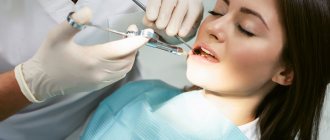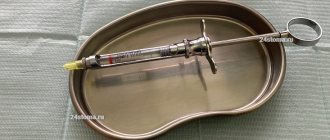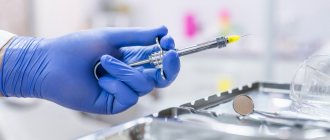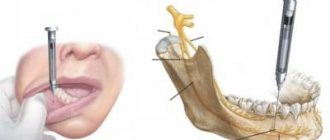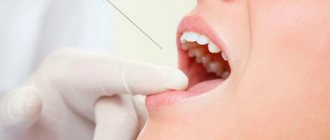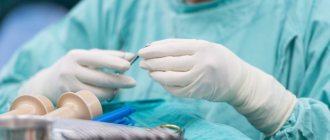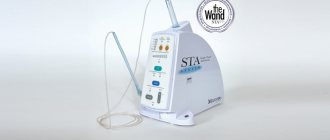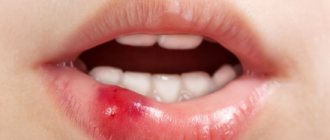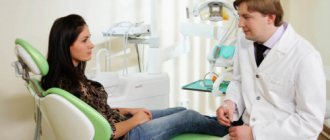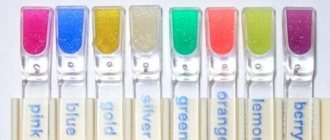From this article you will learn:
- anesthesia in dentistry - drugs,
- types of anesthesia for dental treatment,
- pain relief during pregnancy and breastfeeding.
The article was written by a dental surgeon with more than 19 years of experience.
Local anesthesia is a type of anesthesia, the meaning of which is to block the transmission of pain impulses from the area where the intervention is performed. Options for local anesthesia in dentistry include infiltration, conduction or application anesthesia. They allow you to anesthetize only the area where the intervention is planned (this could be a group of teeth or a fragment of the jaw), while the patient is conscious.
To carry out local anesthesia in dentistry, medications are used that are called “local anesthetics”. But in some cases, for example, during extensive surgical interventions or a person’s panicky fear of treatment or tooth extraction, general anesthesia can also be used, in which, along with pain sensitivity, the patient’s consciousness is temporarily turned off. General anesthesia is performed using narcotic analgesics (administered intravenously or inhaled).
Local anesthesia in dentistry –
The very first local anesthetic in dentistry was novocaine, which, however, did not allow for significant anesthesia and practically did not anesthetize inflamed tissues. Later, lidocaine appeared, which was already about 2-2.5 times stronger in effectiveness, but like novocaine, it did not allow achieving a great depth and duration of anesthesia. A real revolution occurred with the advent of articaine anesthetics (based on articaine hydrochloride), which additionally contained vasoconstrictors.
The most popular local anesthetics in dentistry based on articaine are Ultracaine, Ubistezin, Alfacaine, Septanest and others. To further increase the depth and duration of anesthesia, vasoconstrictors began to be added to these drugs. The latter constrict the blood vessels at the site of injection of the anesthetic, thereby reducing the rate of its leaching from the tissues. Currently, epinephrine is most often used as a vasoconstrictor at a concentration of 1:100,000 and 1:200,000.
Local anesthesia for treatment and extraction of teeth –
If previously novocaine and lidocaine were produced in the form of vials or ampoules, and injections with these drugs were performed using ordinary disposable 5.0 ml syringes, now all modern anesthetics are produced in the form of disposable carpules (cartridges). Each carpule usually contains 1.7 ml of anesthetic, and before anesthesia it is inserted into a special carpule syringe. Next, a very thin needle is screwed on (many times thinner than ordinary needles on disposable syringes), after which the syringe is ready for use.
What does an assembled carpule syringe look like?
Carpule of anesthetic and a special needle –
The cost of anesthetics and anesthesia - the cost of one anesthetic carpule for 2022 (be it ultracaine, ubistezin, septanest or others) - will be approximately 40-50 rubles. This is the price at which dental clinics purchase anesthetics. But the total cost of anesthesia for dental treatment in a dental clinic will be about 400-500 rubles per 1 carpule of anesthetic.
It is also worth noting that pain relief during the treatment and extraction of teeth in dentistry is included in the guarantee program of the health insurance fund. Therefore, anesthesia in public dental clinics should be provided free of charge, but only when using Lidocaine or Novocaine (imported anesthetic will be paid for). Next, we will talk about the types of anesthesia in dentistry.
Flaws
Dentists note the usefulness and convenience of using carpule anesthesia. Among the disadvantages is the high cost. Some patients cannot afford pain relief with a carpule. But doctors justify the cost, because the complexity of manufacturing and efficiency in use entail considerable costs.
Dentists refuse carpule anesthesia in cases where it is necessary to add a vasoconstrictor to the composition. This type of pain relief does not provide such an opportunity.
Types of anesthesia in dentistry - infiltration, conduction, application
As we said above, local anesthesia can be application, infiltration or conduction. Topical anesthesia in dentistry is used to numb the oral mucosa by applying 10% lidocaine in the form of a gel or spray. This type of anesthesia is especially often used in children to pre-numb the place where the needle is inserted. Lidocaine spray is often sprayed onto the root of the tongue in patients with an increased gag reflex.
Infiltration anesthesia in dentistry is most often performed during the treatment and removal of any teeth in the upper jaw, as well as in the area of the anterior teeth of the lower jaw. In this case, the injection is carried out in the transitional fold zone in the projection of the root of the tooth that we will remove or treat (the transitional fold is the zone of transition of the tightly attached mucous membrane into the mobile mucous membrane of the cheek or lip). After the anesthetic is introduced into the tissue, an infiltrate is formed in them, from which the anesthetic quickly penetrates into the bone tissue of the jaw.
Infiltration anesthesia on the upper jaw –
Conductive anesthesia - in dentistry it is most often used to anesthetize 6-7-8 lower teeth (less often than other teeth). This is due to the fact that the bone tissue of the lower jaw is denser and thicker - especially in the last teeth. And therefore, if we perform infiltration anesthesia on the lower molars, the anesthetic simply will not penetrate into the bone and, accordingly, the patient will experience pain. And in this case, conduction anesthesia (mandibular or torus) will help us - the injection is made into the nerve trunk, passing approximately in the middle of the inner surface of the branch of the lower jaw.
Infiltration and conduction anesthesia (video 1-2) –
How long does it take for dental anesthesia to last? The effect of infiltration anesthesia on the upper jaw occurs within a few minutes and lasts from 15 to 45 minutes (this depends on the type of anesthetic and the concentration of the vasoconstrictor in it). The onset of anesthesia is signaled by the appearance of numbness in the cheek or upper lip. The effect of conduction anesthesia on the lower jaw occurs in 5-10 minutes, but it can last from 1 hour to several hours. The following symptoms will tell us about the onset of anesthesia - there must be pronounced numbness in half of the lower lip, as well as the tip of the tongue.
Important: if after conduction anesthesia on the lower jaw, the numbness of half the lip is weak or completely absent, then the doctor missed and was unable to remove the anesthetic near the inferior alveolar nerve (this nerve runs on the inner surface of the branch of the lower jaw, providing pain sensitivity to the teeth on this side). And in this case, you should either ask the doctor to repeat the anesthesia, otherwise the treatment will be painful.
Yes, and I would like to note that in most cases, poor anesthesia is associated only with doctor errors, i.e. with violation of the technique of conduction anesthesia. This type of anesthesia is the most difficult during a general dental appointment, and not all doctors confidently perform conduction anesthesia. However, there are a number of patients in whom it is impossible to achieve good anesthesia in principle. These include patients who abuse analgesics, as well as alcohol and drugs.
Selection of carpule needles
The carpule needle consists of a metal nozzle and a plastic coupling, with the help of which the spear is attached to the body. The product must guarantee effortless, painless injection of the medicinal substance.
It has 2 sides, with the help of which manipulations become harmless. The elongated side of the tip is used to penetrate dental tissues; it ends with a chamfer. The short side is a device for opening impenetrable carpules.
The criteria for selecting a device should be based on the following characteristics:
- Dentists recommend choosing a product that has a red mark indicating the direction of movement of the syringe. This can increase the level of medical manipulations and reduce the time a person spends in the dental chair.
- The metal for the manufacture of products is selected according to the parameters of thickness, reliability, and increased elasticity. This will help avoid infection and eliminate discomfort during the procedure, providing opportunities to reach the most inaccessible places in the oral cavity.
- Needles are selected according to length. There are products on sale with lengths from 10 to 25.5 mm (short) and 28.9-41.5 mm (long).
- Dentists also select needles based on diameter.
Foreign-made needles are more expensive; they are certified to European and American standards. The most expensive products include products from the company Septoject Evolution (a package of 100 pieces can cost 1000-1400 rubles), made from high quality metal.
Products made in Korea and Pakistan are much cheaper (300-500 rubles), which are also of good quality (brands NI-PRO, BIODENT, Sun Pharmaceuticals, Cornerstone Corporation). The cheapest needles will cost you Russian-made needles (AERS), which are not inferior in quality to their foreign counterparts.
All manufacturing companies produce products according to standard parameters of diameter and length: 12, 16, 21, 25, 30, 35, 38 mm.
What to do if you are afraid of anesthesia -
Indeed, an anesthetic injection can be painful. The pain will depend both on the patient’s pain sensitivity threshold and on the doctor’s anesthesia technique. According to the rules, a solution of one anesthetic carpule (1.7 ml) is excreted into the tissue within 40-45 seconds. If the doctor saves time, then it is logical that rapid administration of the solution will cause pain.
To reduce the discomfort from an anesthetic injection, you can ask the doctor to first use a gel or spray with lidocaine to conduct topical anesthesia at the site of the future injection. You can also ask your doctor to administer the anesthetic slowly.
Drugs to relieve fear and anxiety – There are also drugs that can reduce fear and anxiety before an upcoming trip to the dentist. At the same time, there are drugs with a sedative effect such as (Persen forte), and there are drugs only for relieving anxiety, for example, Afobazol. The latter does not have a sedative effect, and it makes sense to start taking it only 10 days before going to the dentist, because... the drug has a cumulative effect (24stoma.ru).
In a number of large clinics, as a premedication, you can also be given an intramuscular injection of diphenhydramine 30 minutes before the start of treatment. You can also use tinctures of valerian, motherwort, Corvalol, valocardine. However, it is also advisable to take these drugs in a course (at least a few days before visiting the doctor), because they also have a cumulative effect. But you need to take into account that these drugs also have a hypnotic effect, which is not very good for motorists and working people.
Storage conditions
The transfer of the technology for the production of anesthetic substances to factory conditions has led to the emergence of guarantees of tightness and sterility of the drug manufacturing process. The spread of carpule instruments made it possible to transfer responsibility for the quality of the administered medicine from doctors to syringe manufacturers.
During procedures, the dentist is required to comply with the following strict rules:
- The anesthetic substance must have permission for use from the Pharmacological Committee of the Russian Ministry of Health.
- The product must be equipped with quality documents, which is confirmed by receiving an expert assessment from specialists.
- Drug labeling must be printed on each unit of product.
- Particular attention must be paid to the expiration date, since the use of expired substances is not allowed.
When storing painkillers, it is necessary to avoid sources of heat and light, that is, carpules should be stored in dry, dark rooms at a temperature no higher than +25°.
During storage of carpules, the following situations may arise:
- The cartridges were frozen and then thawed further. In this case, it is likely that air will enter the cartridge and form bubbles that push the plunger out.
- Small bubbles, which are observed when the plunger plug is intact, can form through the accumulation of nitrogen, which is used to prevent oxygen from penetrating into the capsule. This drug can be used.
- The appearance of rust on the plug proves that the integrity of the cartridge has been damaged.
- A change in the color properties and density of a substance indicates transformations in its chemical formula due to improper preservation.
The needles should also be kept in a place away from sources of moisture, light and heat. The integrity of the packaging must be protected. It is prohibited to use needles that have expired. The devices should be removed from the packaging immediately before the procedure and kept closed with a plastic cap.
Local anesthetics in dentistry –
At the moment, the most modern anesthetics in dentistry are drugs based on articaine hydrochloride. We have already said above that this group also includes Ultracain, Ubistezin, Septanest and others. Anesthetics of the articaine series are more effective than lidocaine - 1.5-2 times, and Novocaine - 5-6 times. As for the duration of anesthesia with drugs based on articaine, it will depend, among other things, on the concentration of vasoconstrictors in the anesthetic composition.
Vasoconstrictors, due to the narrowing of blood vessels at the injection site, can reduce the leaching of the anesthetic, and this leads to an increase in the depth and duration of anesthesia. Manufacturers always produce the same anesthetic with different concentrations of vasoconstrictors. The following concentrations of the vasoconstrictor epinephrine are usually used - 1:100000, 1:200000 + option and without a vasoconstrictor at all. This allows for optimal use of the drug in patients of different risk groups. The most commonly used anesthetics are:
1) Anesthetic “Ultracaine” –
The anesthetic Ultracaine is produced in France in 3 possible versions, which will differ in the presence/absence of epinephrine in the composition, as well as its concentration. A separate article is devoted to this most popular and safe anesthetic (link above). Forms of release of ultracaine:
- “ultracaine DS forte” (with epinephrine concentration 1:100,000),
- “ultracaine DS” (with an epinephrine concentration of 1:200,000),
- "ultracaine D" (without epinephrine, without preservatives).
2) Ubistezin - instructions for use
Good anesthetic, produced (Germany). The composition of Ubistezin is absolutely no different from similar forms of Ultracain, and there are only different release forms. The first option is “Ubistezin” (with an epinephrine concentration of 1:200,000), and the second is “Ubistezin forte” (with an epinephrine concentration of 1:100,000).
Read a detailed description of the anesthetic and its indications for use here: → Ubistezin forte - instructions for use (PDF)
3) Septanest: instructions for use
Septanest has been used in dentistry for a very long time. This anesthetic has 2 release forms with adrenaline concentrations of 1:100,000 and 1:200,000. But compared to ultracaine and ubistezin, this anesthetic contains a slightly larger amount of preservatives (sodium metabisulfite and EDTA), which is undesirable in a number of patients, for example, with frequent allergic reactions, bronchial asthma, etc.
Read a detailed description of the anesthetic and its indications for use here: → Septanest 1:100,000 – instructions for use (PDF)
4) Scandonest: instructions for use
Anesthetic from Septodont (France) based on 3% Mepivacaine.
Does not contain vasoconstrictor components or preservatives. Scandonest in dentistry is used mainly only in patients at risk who cannot take anesthetics with adrenaline and epinephrine, as well as in patients with bronchial asthma. A complete analogue of Scandonest is the anesthetic Mepivastezin, produced (Germany). Read a detailed description of the anesthetic and indications for use here: → Scandonest - instructions for use (PDF)
Equipment
Essentially, a carpule syringe is a metal dental anesthesia syringe that can be used many times and is sterilized in the same way as other dental instruments. A carpule with an anesthetic is inserted into the carpule syringe - a special glass cartridge, factory-made.
Currently, the Trilogy Medical and Dental Center uses carpule syringes for injection anesthesia - they are much more convenient and more sophisticated than conventional disposable syringes.
Which anesthetic is right for you - summary
- For bronchial asthma or high allergies, an anesthetic without preservatives is needed (usually sodium disulfite is used in anesthetics, which is needed to stabilize epinephrine or adrenaline). Therefore, the anesthetic “Ultracain D”, which does not contain any preservatives, is best suited for such patients.
- If you have thyroid disease or diabetes, in this case you also do not want to use anesthetics containing vasoconstrictor components - adrenaline, epinephrine. The drug of choice, for example, Ultracaine D, Scandonest or Mepivastezin. But, choosing between these three anesthetics, I would give preference to the first.
- If you have high blood pressure and heart disease - with moderate hypertension and compensated heart disease, the optimal choice is anesthetics containing a concentration of epinephrine (adrenaline) - 1:200000. This can be anesthetics “Ultracain DS” or “Ubistezin 1:200000”. In case of severe hypertension, decompensated heart disease, it is necessary to use anesthetics that are completely free of adrenaline and epinephrine. Then, for example, “Ultracain D” will do.
- If you are a healthy person - if you do not have the above diseases, then you can safely administer anesthetics containing epinephrine/adrenaline in a concentration of 1:100,000. Moreover, a person weighing about 70 kg can be given up to 7 carpules of anesthetic inclusive. An example of such anesthetics is Ultracain DS Forte, Ubistezin Forte and analogues.
→ The most powerful analgesics for toothache
How to distinguish an original from a fake?
Karpula ensures the sterility of chemical compounds. It also serves to create the necessary pressure in the syringe, which is required during the aspiration test procedure.
The capsule is a cylindrical container made of glass or plastic with a silicone piston placed at one end and a rubber stopper covered with metal at the other end. The inside volume of the cartridge should be 2 ml. However, due to the presence of a stopper, the capacity can be reduced to 1.7-1.8 ml.
Due to incorrect transportation, storage, or the purchase of counterfeits, changes in the presentation of capsules or boxes may occur, which you should pay attention to:
- discrepancy between the color characteristics and density of the substance (yellowness, turbidity, sediment);
- the position of the piston does not correspond to the dimensions of the cartridge, however, bubbles may be observed in the middle of the capsule;
- rust is detected on the cartridge (seal failure);
- The boxes show signs of being dented or have any defects.
When choosing needles, you need to pay attention to the presence of certain quality characteristics that are adhered to by well-known pharmaceutical companies:
- Branded products have a red mark on the outside of the body (on the cut side of the tip).
- Certified products have a thread on the inside of the body into which a syringe of the appropriate size and shape is screwed, according to the type of device.
- Manufacturers package original needles in packages of 100 pieces.
- After sterilization at the factory, the cases are sealed with paper seals or using cutters.
- The labels must clearly indicate the manufacturer's data (location, name), needle marking (length, diameter), production time and shelf life of the product.
